In exercises 1 - 4, determine whether the statements are true or false.
1. If surface \(S\) is given by \(\{(x,y,z) : \, 0 \leq x \leq 1, \, 0 \leq y \leq 1, \, z = 10 \}\), then \(\displaystyle \iint_S f(x,y,z) \, dS = \int_0^1 \int_0^1 f (x,y,10) \, dx \, dy.\)
2. If surface \(S\) is given by \(\{(x,y,z) : \, 0 \leq x \leq 1, \, 0 \leq y \leq 1, \, z = x \}\), then \(\displaystyle \iint_S f(x,y,z) \, dS = \int_0^1 \int_0^1 f (x,y,x) \, dx \, dy.\)
3. Surface \(\vecs r = \langle v \, \cos u, \, v \, \sin u, \, v^2 \rangle,\) for \( 0 \leq u \leq \pi, \, 0 \leq v \leq 2\) is the same surface \(\vecs r = \langle \sqrt{v} \, \cos 2u, \, \sqrt{v} \, \sin 2u, \, v \rangle,\) for \( 0 \leq u \leq \dfrac{\pi}{2}, \, 0 \leq v \leq 4\).
4. Given the standard parameterization of a sphere, normal vectors \(t_u \times t_v\) are outward normal vectors.
In exercises 5 - 10, find parametric descriptions for the following surfaces.
5. Plane \(3x - 2y + z = 2\)
- Answer
- \(\vecs r(u,v) = \langle u, \, v, \, 2 - 3u + 2v \rangle \) for \(-\infty \leq u < \infty\) and \( - \infty \leq v < \infty\).
6. Paraboloid \(z = x^2 + y^2\), for \(0 \leq z \leq 9\).
7. Plane \(2x - 4y + 3z = 16\)
- Answer
- \(\vecs r(u,v) = \langle u, \, v, \, \dfrac{1}{3} (16 - 2u + 4v) \rangle \) for \(|u| < \infty\) and \(|v| < \infty\).
8. The frustum of cone \(z^2 = x^2 + y^2\), for \(2 \leq z \leq 8\)
9. The portion of cylinder \(x^2 + y^2 = 9\) in the first octant, for \(0 \leq z \leq 3\)
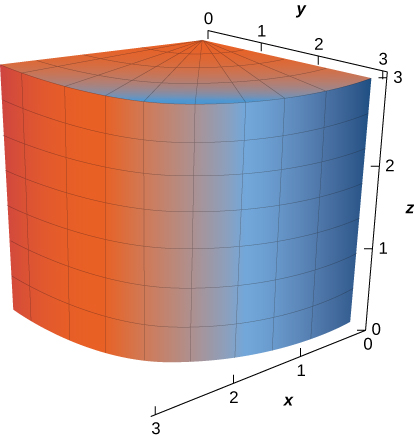
- Answer
- \(\vecs r(u,v) = \langle 3 \, \cos u, \, 3 \, \sin u, \, v \rangle \) for \(0 \leq u \leq \dfrac{\pi}{2}, \, 0 \leq v \leq 3\)
10. A cone with base radius \(r\) and height \(h,\) where \(r\) and \(h\) are positive constants.
For exercises 11 - 12, use a computer algebra system to approximate the area of the following surfaces using a parametric description of the surface.
11. [T] Half cylinder \(\{ (r, \theta, z) : \, r = 4, \, 0 \leq \theta \leq \pi, \, 0 \leq z \leq 7 \}\)
12. [T] Plane \(z = 10 - z - y\) above square \(|x| \leq 2, \, |y| \leq 2\)
In exercises 13 - 15, let \(S\) be the hemisphere \(x^2 + y^2 + z^2 = 4\), with \(z \geq 0\), and evaluate each surface integral, in the counterclockwise direction.
13. \(\displaystyle \iint_S z\, dS\)
- Answer
- \(\displaystyle \iint_S z \, dS = 8\pi\)
14. \(\displaystyle \iint_S (x - 2y) \, dS\)
15. \(\displaystyle \iint_S (x^2 + y^2) \, dS\)
- Answer
- \(\displaystyle \iint_S (x^2 + y^2) \, dS = 16 \pi\)
In exercises 16 - 18, evaluate \(\displaystyle \int \int_S \vecs F \cdot \vecs N \, dS\) for vector field \(\vecs F\) where \(\vecs N\) is an outward normal vector to surface \(S\).
16. \(\vecs F(x,y,z) = x\,\mathbf{\hat i}+ 2y\,\mathbf{\hat j} = 3z\,\mathbf{\hat k}\), and \(S\) is that part of plane \(15x - 12y + 3z = 6\) that lies above unit square \(0 \leq x \leq 1, \, 0 \leq y \leq 1\).
17. \(\vecs F(x,y) = x\,\mathbf{\hat i} + y\,\mathbf{\hat j}\), and \(S\) is hemisphere \(z = \sqrt{1 - x^2 - y^2}\).
- Answer
- \(\displaystyle \iint_S \vecs F \cdot \vecs N \, dS = \dfrac{4\pi}{3}\)
18. \(\vecs F(x,y,z) = x^2\,\mathbf{\hat i} + y^2\,\mathbf{\hat j} + z^2\,\mathbf{\hat k}\), and \(S\) is the portion of plane \(z = y + 1\) that lies inside cylinder \(x^2 + y^2 = 1\).
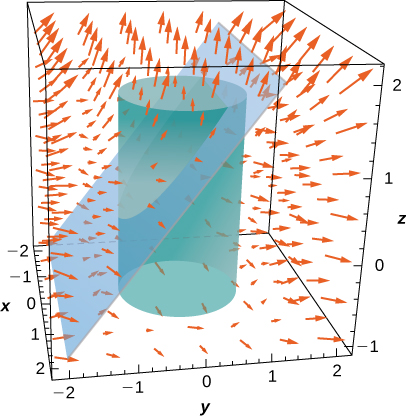
In exercises 19 - 20, approximate the mass of the homogeneous lamina that has the shape of given surface \(S\). Round to four decimal places.
19. [T] \(S\) is surface \(z = 4 - x - 2y\), with \(z \geq 0, \, x \geq 0, \, y \geq 0; \, \xi = x.\)
- Answer
- \(m \approx 13.0639\)
20. [T] \(S\) is surface \(z = x^2 + y^2\), with \(z \leq 1; \, \xi = z\).
21. [T] \(S\) is surface \(x^2 + y^2 + x^2 = 5\), with \(z \geq 1; \, \xi = \theta^2\).
- Answer
- \(m \approx 228.5313\)
22. Evaluate \(\displaystyle \iint_S (y^2 z\,\mathbf{\hat i}+ y^3\,\mathbf{\hat j} + xz\,\mathbf{\hat k}) \cdot dS,\) where \(S\) is the surface of cube \(-1 \leq x \leq 1, \, -1 \leq y \leq 1\), and \(0 \leq z \leq 2\) in a counterclockwise direction.
23. Evaluate surface integral \(\displaystyle \iint_S g \, dS,\) where \(g(x,y,z) = xz + 2x^2 - 3xy\) and \(S\) is the portion of plane \(2x - 3y + z = 6\) that lies over unit square \(R: 0 \leq x \leq 1, \, 0 \leq y \leq 1\).
- Answer
- \(\displaystyle \iint_S g\,dS = 3 \sqrt{4}\)
24. Evaluate \(\displaystyle \iint_S (x + y + z)\, dS,\) where \(S\) is the surface defined parametrically by \(\vecs R(u,v) = (2u + v)\,\mathbf{\hat i} + (u - 2v)\,\mathbf{\hat j} + (u + 3v)\,\mathbf{\hat k}\) for \(0 \leq u \leq 1\), and \(0 \leq v \leq 2\).
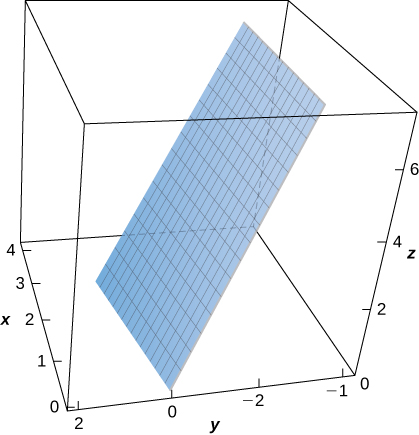
25. [T] Evaluate \(\displaystyle \iint_S (x - y^2 + z)\, dS,\) where \(S\) is the surface defined parametrically by \(\vecs R(u,v) = u^2\,\mathbf{\hat i} + v\,\mathbf{\hat j} + u\,\mathbf{\hat k}\) for \(0 \leq u \leq 1, \, 0 \leq v \leq 1\).
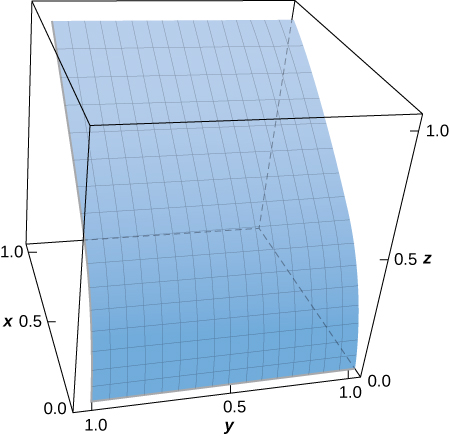
- Answer
- \(\displaystyle \iint_S (x^2 + y - z) \, dS \approx 0.9617\)
26. [T] Evaluate where \(S\) is the surface defined by \(\vecs R(u,v) = u\,\mathbf{\hat i} - u^2\,\mathbf{\hat j} + v\,\mathbf{\hat k}, \, 0 \leq u \leq 2, \, 0 \leq v \leq 1\) for \(0 \leq u \leq 1, \, 0 \leq v \leq 2\).
27. Evaluate \(\displaystyle \iint_S (x^2 + y^2) \, dS,\) where \(S\) is the surface bounded above hemisphere \(z = \sqrt{1 - x^2 - y^2}\), and below by plane \(z = 0\).
- Answer
- \(\displaystyle \iint_S (x^2 + y^2) \, dS = \dfrac{4\pi}{3}\)
28. Evaluate \(\displaystyle \iint_S (x^2 + y^2 + z^2) \, dS,\) where \(S\) is the portion of plane that lies inside cylinder \(x^2 + y^2 = 1\).
29. [T] Evaluate \(\displaystyle \iint_S x^2 z \, dS,\) where \(S\) is the portion of cone \(z^2 = x^2 + y^2\) that lies between planes \(z = 1\) and \(z = 4\).
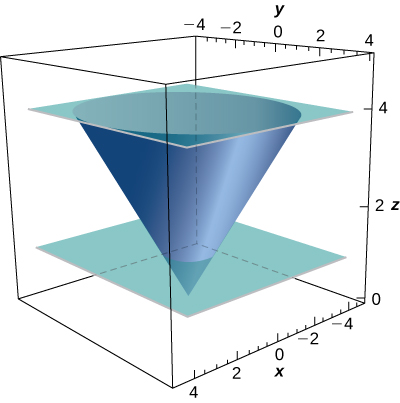
- Answer
- \(\text{div}\,\vecs F = a + b\)
\(\displaystyle \iint_S x^2 zdS = \dfrac{1023\sqrt{2\pi}}{5}\)
30. [T] Evaluate \(\displaystyle \iint_S \frac{xz}{y} \, dS,\) where \(S\) is the portion of cylinder \(x = y^2\) that lies in the first octant between planes \(z = 0, \, z = 5\), and \(y = 4\).
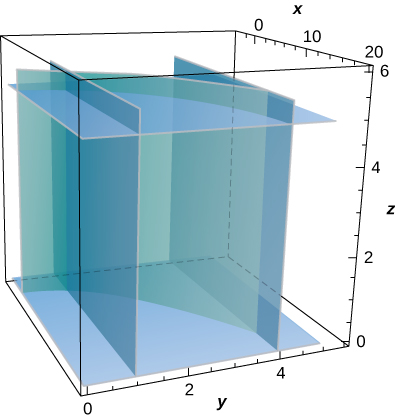
31. [T] Evaluate \(\displaystyle \iint_S (z + y) \, dS,\) where \(S\) is the part of the graph of \( z = \sqrt{1 - x^2}\) in the first octant between the \(xy\)-plane and plane \(y = 3\).
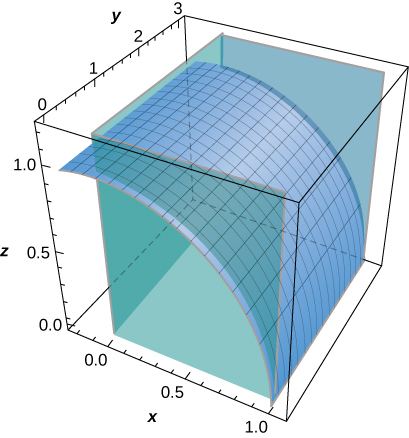
- Answer
- \(\displaystyle \iint_S (z + y) \, dS \approx 10.1\)
32. Evaluate \(\displaystyle \iint_S xyz\, dS\) if \(S\) is the part of plane \(z = x + y\) that lies over the triangular region in the \(xy\)-plane with vertices (0, 0, 0), (1, 0, 0), and (0, 2, 0).
33. Find the mass of a lamina of density \(\xi (x,y,z) = z\) in the shape of hemisphere \(z = (a^2 - x^2 - y^2)^{1/2}\).
34. Compute \(\displaystyle \int \int_S \vecs F \cdot \vecs N \, dS,\) where \(\vecs F(x,y,z) = x\,\mathbf{\hat i} - 5y\,\mathbf{\hat j} + 4z\,\mathbf{\hat k}\) and \(\vecs N\) is an outward normal vector \(S,\) where \(S\) is the union of two squares \(S_1\) : \(x = 0, \, 0 \leq y \leq 1, \, 0 \leq z \leq 1\) and \(S_2 \, : \, x = 0, \, 0 \leq x \leq 1, \, 0 \leq y \leq 1\).
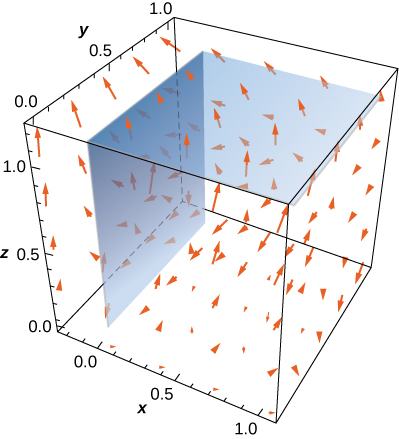
35. Compute \(\displaystyle \int \int_S \vecs F \cdot \vecs N \, dS,\) where \(\vecs F(x,y,z) = xy\,\mathbf{\hat i} + z\,\mathbf{\hat j} + (x + y)\,\mathbf{\hat k}\) and \(\vecs N\) is an outward normal vector \(S,\) where \(S\) is the triangular region cut off from plane \(x + y + z = 1\) by the positive coordinate axes.
- Answer
- \(\displaystyle \iint_S \vecs F \cdot \vecs N \, dS = \dfrac{13}{24}\)
36. Compute \(\displaystyle \int \int_S \vecs F \cdot \vecs N \, dS,\) where \(\vecs F(x,y,z) = 2yz\,\mathbf{\hat i} + (\tan^{-1}xz)\,\mathbf{\hat j} + e^{xy}\,\mathbf{\hat k}\) and \(\vecs N\) is an outward normal vector \(S,\) where \(S\) is the surface of sphere \(x^2 + y^2 + z^2 = 1\).
37. Compute \(\displaystyle \int \int_S \vecs F \cdot \vecs N \, dS,\) where \(\vecs F(x,y,z) = xyz\,\mathbf{\hat i} + xyz\,\mathbf{\hat j} + xyz\,\mathbf{\hat k}\) and \(\vecs N\) is an outward normal vector \(S,\) where \(S\) is the surface of the five faces of the unit cube \(0 \leq x \leq 1, \, 0 \leq y \leq 1, \, 0 \leq z \leq 1\) missing \(z = 0\).
- Answer
- \(\displaystyle \iint_S \vecs F \cdot \vecs N \, dS = \dfrac{3}{4}\)
For exercises 38 - 39, express the surface integral as an iterated double integral by using a projection on \(S\) on the \(yz\)-plane.
38. \(\displaystyle \iint_S xy^2 z^3 \, dS;\) \(S\) is the first-octant portion of plane \(2x + 3y + 4z = 12\).
39. \(\displaystyle \iint_S (x^2 - 2y + z) \, dS;\) \(S\) is the portion of the graph of \(4x + y = 8\) bounded by the coordinate planes and plane \(z = 6\).
- Answer
- \(\displaystyle \int_0^8 \int_0^6 \left( 4 - 3y + \dfrac{1}{16} y^2 + z \right) \left(\dfrac{1}{4} \sqrt{17} \right) \, dz \, dy\)
For exercises 40 - 41, express the surface integral as an iterated double integral by using a projection on \(S\) on the \(xz\)-plane.
40. \(\displaystyle \iint_S xy^2z^3 \, dS;\) \(S\) is the first-octant portion of plane \(2x + 3y + 4z = 12\).
41. \(\displaystyle \iint_S (x^2 - 2y + z) \, dS;\) is the portion of the graph of \(4x + y = 8\) bounded by the coordinate planes and plane \(z = 6\).
- Answer
- \(\displaystyle \int_0^2 \int_0^6 \big[x^2 - 2 (8 - 4x) + z\big] \sqrt{17} \, dz \, dx\)
42. Evaluate surface integral \(\displaystyle \iint_S yz \, dS,\) where \(S\) is the first-octant part of plane \(x + y + z = \lambda\), where \(\lambda\) is a positive constant.
43. Evaluate surface integral \(\displaystyle \iint_S (x^2 z + y^2 z) \, dS,\) where \(S\) is hemisphere \(x^2 + y^2 + z^2 = a^2, \, z \geq 0.\)
- Answer
- \(\displaystyle \iint_S (x^2 z + y^2 z) \, dS = \dfrac{\pi a^5}{2}\)
44. Evaluate surface integral \(\displaystyle \iint_S z \, dA,\) where \(S\) is surface \(z = \sqrt{x^2 + y^2}, \, 0 \leq z \leq 2\).
45. Evaluate surface integral \(\displaystyle \iint_S x^2 yz \, dS,\) where \(S\) is the part of plane \(z = 1 + 2x + 3y\) that lies above rectangle \(0 \leq x \leq 3\) and \(0 \leq y \leq 2\).
- Answer
- \(\displaystyle \iint_S x^2 yz \, dS = 171 \sqrt{14}\)
46. Evaluate surface integral \(\displaystyle \iint_S yz \, dS,\) where \(S\) is plane \(x + y + z = 1\) that lies in the first octant.
47. Evaluate surface integral \(\displaystyle \iint_S yz \, dS,\) where \(S\) is the part of plane \(z = y + 3\) that lies inside cylinder \(x^2 + y^2 = 1\).
- Answer
- \(\displaystyle \iint_S yz \, dS = \dfrac{\sqrt{2}\pi}{4}\)
For exercises 48 - 50, use geometric reasoning to evaluate the given surface integrals.
48. \(\displaystyle \iint_S \sqrt{x^2 + y^2 + z^2} \, dS,\) where \(S\) is surface \(x^2 + y^2 + z^2 = 4, \, z \geq 0\)
49. \(\displaystyle \iint_S (x\,\mathbf{\hat i} + y\,\mathbf{\hat j}) \cdot dS,\) where \(S\) is surface \(x^2 + y^2 = 4, \, 1 \leq z \leq 3\), oriented with unit normal vectors pointing outward
- Answer
- \(\displaystyle \iint_S (x\,\mathbf{\hat i} + y\,\mathbf{\hat j}) \cdot dS = 16 \pi\)
50. \(\displaystyle \iint_S (z\,\mathbf{\hat k}) \cdot dS,\) where \(S\) is disc \(x^2 + y^2 \leq 9\) on plane \(z = 4\) oriented with unit normal vectors pointing upward
51. A lamina has the shape of a portion of sphere \(x^2 + y^2 + z^2 = a^2\) that lies within cone \(z = \sqrt{x^2 + y^2}\). Let \(S\) be the spherical shell centered at the origin with radius a, and let \(C\) be the right circular cone with a vertex at the origin and an axis of symmetry that coincides with the \(z\)-axis. Determine the mass of the lamina if \(\delta(x,y,z) = x^2 y^2 z\).
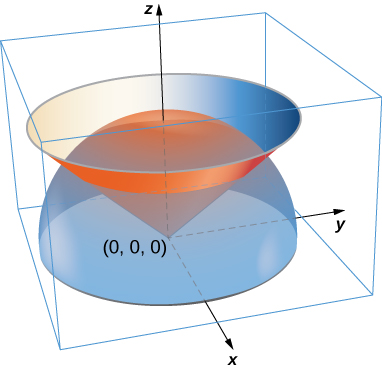
- Answer
- \(m = \dfrac{\pi a^7}{192}\)
52. A lamina has the shape of a portion of sphere \(x^2 + y^2 + z^2 = a^2\) that lies within cone \(z = \sqrt{x^2 + y^2}\). Let \(S\) be the spherical shell centered at the origin with radius a, and let \(C\) be the right circular cone with a vertex at the origin and an axis of symmetry that coincides with the z-axis. Suppose the vertex angle of the cone is \(\phi_0\), with \(0 \leq \phi_0 < \dfrac{\pi}{2}\). Determine the mass of that portion of the shape enclosed in the intersection of \(S\) and \(C.\) Assume \(\delta(x,y,z) = x^2y^2z.\)
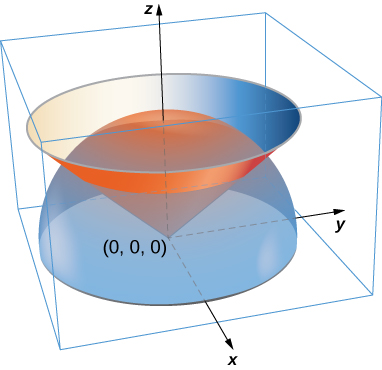
53. A paper cup has the shape of an inverted right circular cone of height 6 in. and radius of top 3 in. If the cup is full of water weighing \(62.5 \, lb/ft^3\), find the magnitude of the total force exerted by the water on the inside surface of the cup.
- Answer
- \(F \approx 4.57 \, lb\)
For exercises 54 - 55, the heat flow vector field for conducting objects is \(\vecs F = - k\vecs\nabla T\), where \(T(x,y,z)\) is the temperature in the object and \(k > 0\) is a constant that depends on the material. Find the outward flux of \(\vecs F\) across the following surfaces \(S\) for the given temperature distributions and assume \(k = 1\).
54. \(T(x,y,z) = 100 e^{-x-y}\); \(S\) consists of the faces of cube \(|x| \leq 1, \, |y| \leq 1, \, |z| \leq 1\).
55. \(T(x,y,z) = - \ln (x^2 + y^2 + z^2)\); \(S\) is sphere \(x^2 + y^2 + z^2 = a^2\).
For exercises 56 - 57, consider the radial fields \(\vecs F = \dfrac{\langle x,y,z \rangle}{(x^2+y^2+z^2)^{\dfrac{p}{2}}} = \dfrac{r}{|r|^p}\), where \(p\) is a real number. Let \(S\) consist of spheres \(A\) and \(B\) centered at the origin with radii \(0 < a < b\). The total outward flux across \(S\) consists of the outward flux across the outer sphere \(B\) less the flux into \(S\) across inner sphere \(A\).
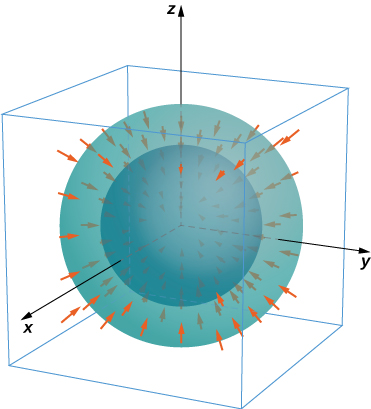
56. Find the total flux across \(S\) with \(p = 0\).
57. Show that for \(p = 3\) the flux across \(S\) is independent of \(a\) and \(b.\)
- Answer
- The net flux is zero.
Contributors
Gilbert Strang (MIT) and Edwin “Jed” Herman (Harvey Mudd) with many contributing authors. This content by OpenStax is licensed with a CC-BY-SA-NC 4.0 license. Download for free at http://cnx.org.













